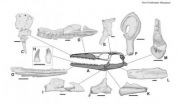(Press-News.org) Humpback whales might be expected to take their food seriously given their enormous size, but a new study shows that they may multi-task as they eat, singing mating or breeding songs as they forage in their Antarctic feeding grounds. The research, published December 19 in the open-access journal PLOS ONE by Alison Stimpert from the Naval Postgraduate School and colleagues, sheds new light on the whales' singing habits in different seasons, which are still a mystery.
Whales sing most frequently during the breeding season but are known to sing on other occasions, such as while escorting mother-calf pairs along migratory routes. Though the reasons that whales sing are still unknown, the distinction between their seasonal behaviors is clear. Breeding, migration and foraging occur in different regions and times of the year, and rarely overlap.
In the current study, the researchers tracked ten whales to study singing behavior in their foraging grounds. They found that all ten sang while foraging, but two of the whales showed intense, continuous bouts of singing similar to what the researchers expected to see in breeding grounds. They also found the whales sang for up to an hour at a time and during active diving periods.
AUDIO:
This is audio for Stimpert AK, Peavey LE, Friedlaender AS, Nowacek DP (2012) Humpback Whale Song and Foraging Behavior on an Antarctic Feeding Ground. PLoS ONE 7(12): e51214. doi:10.1371/journal.pone.0051214...
Click here for more information.
According to the authors, their data reveal a previously unknown behavioral flexibility, where humpbacks can balance the competing needs to feed continuously to prepare for breeding with mating behaviors like song displays. They suggest that this may also signify an ability to engage in breeding activities outside of the traditional, warm water breeding ground locations. Stimpert adds, "We were surprised to find such structured song in the Antarctic feeding ground. The tag data are also exciting because this is the first time that we can see that the singers aren't sitting off by themselves like they do on the breeding grounds -- they're right in the midst of the feeding action, choosing to sing instead."
AUDIO:
This is audio for Stimpert AK, Peavey LE, Friedlaender AS, Nowacek DP (2012) Humpback Whale Song and Foraging Behavior on an Antarctic Feeding Ground. PLoS ONE 7(12): e51214. doi:10.1371/journal.pone.0051214....
Click here for more information.
INFORMATION:
Citation: Stimpert AK, Peavey LE, Friedlaender AS, Nowacek DP (2012) Humpback Whale Song and Foraging Behavior on an Antarctic Feeding Ground. PLoS ONE 7(12): e51214. doi:10.1371/journal.pone.0051214
Financial Disclosure: This material is based upon work supported by the National Science Foundation under Grant No. ANT-07-39483. The authors also gratefully acknowledge funding support from the F. V. Hunt Fellowship of the Acoustical Society of America. The funders had no role in study design, data collection and analysis, decision to publish, or preparation of the manuscript.
Competing Interest Statement: The authors have declared that no competing interests exist.
PLEASE LINK TO THE SCIENTIFIC ARTICLE IN ONLINE VERSIONS OF YOUR REPORT (URL goes live after the embargo ends): http://dx.plos.org/10.1371/journal.pone.0051214
Music with dinner: Whales sing during foraging season, not just while breeding
Based on their song, humpback whales show unexpected flexibility with mating and feeding behaviors
2012-12-20
ELSE PRESS RELEASES FROM THIS DATE:
First freshwater mosasaur discovered
2012-12-20
A new mosasaur species discovered in Hungary is the first known example of this group of scaled reptiles to have lived in freshwater river environments similar to modern freshwater dolphins, according to research published December 19 in the open-access journal PLOS ONE by Laszlo Makadi from the Hungarian Natural History Museum, Hungary and colleagues from the University of Alberta, Canada and MTA-ELTE Lendület Dinosaur Research Group, Hungary.
The species lived about 84 million years ago, the largest specimens reached about 20 feet in length, and belongs to a family ...
Transplanted neural stem cells treat ALS in mouse model
2012-12-20
LA JOLLA, Calif., December 19, 2012 – Amyotrophic lateral sclerosis (ALS), also known as Lou Gehrig's disease, is untreatable and fatal. Nerve cells in the spinal cord die, eventually taking away a person's ability to move or even breathe. A consortium of ALS researchers at multiple institutions, including Sanford-Burnham Medical Research Institute, Brigham and Women's Hospital, and the University of Massachusetts Medical School, tested transplanted neural stem cells as a treatment for the disease. In 11 independent studies, they found that transplanting neural stem cells ...
Unraveling the threads: Simplest cotton genome offers clues for fiber improvements
2012-12-20
From the stockings decorating mantles to the new outfits in display windows calling to shoppers, cotton is woven into the fabric of the holiday season. For bioenergy researchers, however, fiber composition matters more than color and texture as each cotton strand is composed of more than two dozen coils of cellulose, a target biomass for next-generation biofuels.
In the December 20, 2012 edition of Nature, an international consortium of researchers from 31 institutions including a team from the U.S. Department of Energy Joint Genome Institute (DOE JGI) present a high-quality ...
Occasional family meals enough to boost kids' fruit and veg intake
2012-12-20
Eating meals together as a family, even if only once or twice a week, increases children's daily fruit and vegetable intake to near the recommended 5 A Day, according to researchers at the University of Leeds.
The study of primary school-aged children, funded by the National Institute for Health Research Public Health Research (NIHR PHR) Programme, also suggests parental consumption of fruit and vegetables and cutting up portions of these foods boosted children's intake. It is published today in the British Medical Journal's Journal of Epidemiology & Community Health.
Overall, ...
Stars reveal the secrets of looking young
2012-12-20
Globular clusters are spherical collections of stars, tightly bound to each other by their mutual gravity. Relics of the early years of the Universe, with ages of typically 12-13 billion years (the Big Bang took place 13.7 billion years ago), there are roughly 150 globular clusters in the Milky Way and they contain many of our galaxy's oldest stars.
But while the stars are old and the clusters formed in the distant past, astronomers using the MPG/ESO 2.2-metre telescope and the NASA/ESA Hubble Space Telescope have found that some of these clusters are still young at heart. ...
How to look young when you're not
2012-12-20
Globular clusters are spherical collections of stars, tightly bound to each other by their mutual gravity. Relics of the early years of the Universe, with ages of typically 12-13 billion years (the Big Bang took place 13.7 billion years ago), there are roughly 150 globular clusters in the Milky Way and they contain many of our galaxy's oldest stars.
But while the stars are old and the clusters formed in the distant past, astronomers using the NASA/ESA Hubble Space Telescope and the MPG/ESO 2.2-metre telescope at the ESO La Silla Observatory have found that some of these ...
JILA physicists achieve elusive 'evaporative cooling' of molecules
2012-12-20
Achieving a goal considered nearly impossible, JILA physicists have chilled a gas of molecules to very low temperatures by adapting the familiar process by which a hot cup of coffee cools.
Evaporative cooling has long been used to cool atoms, at JILA and elsewhere, to extraordinarily low temperatures. The process was used at JILA in 1995 to create a then-new state of matter, the Bose-Einstein condensate (BEC) of rubidium atoms. The latest demonstration, reported in the Dec. 20, 2012, issue of Nature,* marks the first time evaporative cooling has been achieved with molecules—two ...
Scientists develop technique to help prevent inherited disorders in humans
2012-12-20
NEW YORK, NY (December 19, 2012) – A joint team of scientists from The New York Stem Cell Foundation (NYSCF) Laboratory and Columbia University Medical Center (CUMC) has developed a technique that may prevent the inheritance of mitochondrial diseases in children. The study is published online today in Nature.
Dieter Egli, PhD, and Daniel Paull, PhD, of the NYSCF Laboratory with Mark Sauer, MD, and Michio Hirano, MD, of CUMC demonstrated how the nucleus of a cell can be successfully
transferred between human egg cells. This landmark achievement carries significant implications ...
Scientists establish link between inflammatory process and progression of Alzheimer's disease
2012-12-20
WORCESTER, MA — An international team of researchers from the University of Massachusetts Medical School, the University of Bonn and the Center for Advanced European Studies and Research in Germany have shown that a well-known immune and inflammatory process plays an important role in the pathology of Alzheimer's disease. This process, which results in the mature production of the pro-inflammatory cytokine called interleukin-1 beta (IL-1B) and is involved in the body's defense against infection, has also been established as a clinical target for rheumatoid arthritis. The ...
NYSCF and CUMC scientists develop scientific technique to help prevent inherited disorders in humans
2012-12-20
NEW YORK, NY (December 19, 2012) – A joint team of scientists from The New York Stem Cell Foundation (NYSCF) Laboratory and Columbia University Medical Center (CUMC) has developed a technique that may prevent the inheritance of mitochondrial diseases in children. The study is published online today in Nature.
Dieter Egli, PhD, and Daniel Paull, PhD, of the NYSCF Laboratory with Mark Sauer, MD, and Michio Hirano, MD, of CUMC demonstrated how the nucleus of a cell can be successfully transferred between human egg cells. This landmark achievement carries significant implications ...
LAST 30 PRESS RELEASES:
Penn researchers awarded $25M to conduct trial using smartphones to fight heart disease
PCORI awards funding for new patient-centered healthcare research
Exploring the origins of the universe: 145 low-noise amplifiers complete ALMA telescopes
Empress cicada wings help illuminate molecular structure
Using sound waves to detect helium
Time burden in patients with metastatic breast and ovarian cancer from clinic and home demands
Researchers discover bias in AI models that analyze pathology samples
Scientists ID potential way to prevent brain injuries from triggering Alzheimer's
MASTER 2nd Open Call: Execution period kick-off
Algae for health in food and pharma
Advanced microrobots driven by acoustic and magnetic fields for biomedical applications
Chicago health information leader recognized for raising CPR readiness and blood pressure awareness
The Intimate Animal, a new book from Kinsey Institute Executive Director Dr. Justin Garcia
When blue-collar workers lose union protection, they try self-employment
New video dataset to advance AI for health care
MEA-based graph deviation network for early autism syndrome signatures in human forebrain organoids
New modeling approach sheds light on rare gut disease
Study documents potentially hazardous flame retardants in firefighter gear
Can certain bacteria regulate aging of the immune system and its related alterations?
AI model helps diagnose often undetected heart disease from simple EKG
There are fewer online trolls than people think
Cell membrane fluctuations produce electricity
Jeonbuk National University study shows positive parenting can protect adolescents against self-harm
Surface-engineered ZnO nanocrystals to tackle perfluoroalkyl substance contamination
This new understanding of T cell receptors may improve cancer immunotherapies
A new fossil face sheds light on early migrations of ancient human ancestor
A new immunotherapy approach could work for many types of cancer
A new way to diagnose deadly lung infections and save lives
40 percent of MRI signals do not correspond to actual brain activity
How brain-inspired algorithms could drive down AI energy costs
[Press-News.org] Music with dinner: Whales sing during foraging season, not just while breedingBased on their song, humpback whales show unexpected flexibility with mating and feeding behaviors





